|
ACADIA NATURE NOTES
| Volume 5 |
Spring Number, 1939 |
Number 1 |
FLOWERS WHITE
SHAD-BUSH
April - May
Amelanchier canadensis - Rose family.
Found in swamps and moist soil.
| Stem |
Sometimes 30' high. Shrub or tree. |
 |
| Leaves |
Oval, oblong, elliptic, acute at the apex, rounded, or
sometimes narrowed at the base, finely and sharply
toothed nearly all around, seldom over 1" long. |
| Flower |
Densely white - woolly when young, often nearly or quite
glabrous when old, 5 petals, 5 sepals. |
| Fruit |
A sweet, edible berry-like miniature apple smaller than peas and varying
in color from crimson through magenta to dark or black purple. |
Throughout New England this plant is knovn by the common name Sugar
Pear. It is frequently gathered to make jelly. As well as providing
food for people, it is also food for many of the birds, especially the
thrushes.
Other species of this vicinity and of similar aspect are A.
laevis, A. oligocarpa, and A. oblonifolia.
FLOWERS WHITE
PUSSY-TOES or LADIES TOBACCO
Late May - Early June
Antennaria plantaginifolia - Composite family.
Perennial, found in dry fields, hillside pastures, and open woods
in early spring.
| Root |
Slender, fibrous. |
 |
| Stem |
Downy or woolly; the erect flowering stems 6"-8" high; leafy
runners spread in all directions. |
| Leaves |
Silky, woolly when young, at length green above and silvery
beneath; those of the flowering stems alternate, small,
lance-shaped; the basal leaves are oval, rather large, three
ribbed, white at first. |
| Flower-heads |
White, small, silky-haired, silvery white, borne in
clusters at the summit of the stem. Blossom made up of many tiny
florets. |
Antennaria is named from the resemblance of the flower husk, after
fruiting, to the antennae of certain insects.
The flowering heads differ in appearance. Some are small and pointed (A;
others larger and rather flat at the top (B). The smaller (A) which bear
pistils only, are silvery white; the others are creamy white with
brownish, orange-tipped stamens, which give a brownish color to the
heads (B). After those heads have shed their pollen, which happens by
early June, they droop, the stems wither, and a general collapse sets
in. Their work is done. The others, the pointed pistillate heads, wax
strong, the stems grow high, keeping level with the grass and their
heads take on a tinge of color. By July the seeds are mature and the
plant becomes lost in the surrounding foliage.
FLOWERS WHITE
WILD SARSAPARILLA
June
Aralia nudicaulis - Ginseng family
Perennial. Rich, shady, moist woods.
| Root |
Long, horizontal, aromatic. |
 |
| Stem |
Short, inconspicuous; this bears one leaf-stem and one
flower-stem. |
| Flower stalk |
Bears from three to five, usually three
umbrella-shaped clusters of greenish-white flowers. |
| Leaves |
Long-stalked, compounded of three divisions, each of
which has five leaflets, oblong-oval, toothed, pointed. |
| Flowers |
Small, greenish white, borne in three to five
umbrella-shaped clusters at the top of the flower-stem.
Clusters two or more inches across. Five sepals joined into a tube. Five
petals, oblong, strongly reflexed. Five stamens, alternate with the
petals, conspicuous. Ovary two to five-celled; styles two to
five. |
| Fruit |
Shining, dark-purple berries in clusters. |
Pollinated by flies and bees.
The true plant stem hardly gets above the ground. The aromatic root is
used as a substitute for the true sarsaparilla (Smilax officinalis of
Mexico and South America). It is popular as a general remedy for various
aliments.
FLOWERS WHITE
BEARBERRY
Early June
Arctostaphylos uva-ursi - Heath family.
On exposed, rocky ledges usually. on mountain slopes.
| Stem |
Somewhat shrubby, hairy, rough branches. |
 |
| Leaves |
Thick, dark evergreen, rounded
at the tip, narrowed at the base, finely veined, 1/2"-1" long. |
| Flowers |
White, bell or vase-shaped,
1/6" long in terminal clusters. |
| Fruit |
Opaque, red, berry-like,
rather dry and tasteless. |
Largely restricted to mountain tops on Mt. Desert Island.
The scientific name means literally "a bear", "a berry".
FLOWERS WHITE
MOUNTAIN SANDWORT or STARWORT
June - September
Arenaria groenlandica - Pink family.
Found on dry rocks, usually on mountain tops.
| Rootstock |
Slender, densely tufted, smooth. |
 |
| Stem |
Slender, 2"-5" high. |
| Leaves |
Slender, thread-like. |
| Flowers |
1/4"-1/2" broad, sepals oblong, petals notched at tip. |
| Fruit |
Oblong pod. |
This common resident of the Cadillac Mountain summit is a native of
Greenland and Labrador and was probably carried down to New England on
the last continental ice sheet, 25,000 years ago.
FLOWERS WHITE
SHEPHERD'S PURSE
May - September
Capsella Bursa-pastoris - Mustard family.
A common weed growing in fields, waste places and along roadsides.
| Root |
Deep, fibrous. |
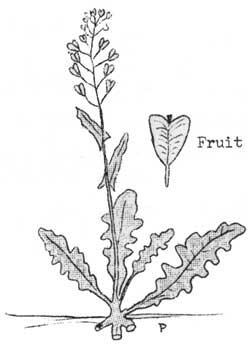 |
| Stem |
6"-18" high, branching. |
| Leaves |
Clustered in a rosette at the base of the stern, toothed,
2"-5" long; stem leaves shorter, clasping. |
| Flowers |
White, small, a long series of single blossoms at the top of the
flowering stalk. Four petals, four sepals, six stamens. |
| Fruit |
Heart-shaped, or purse-shaped pod. Very variable in fruit
shape. |
Shepherd's Purse is one of the hardy weeds that send up seedlings in the
autumn. The seedlings withstand the cold winter and bloom in the early
spring.
The long blooming period from May to September is due to the fact that
all the blossoms grow from the side of the stem, hence the growing tip,
which never bears a blossom, can grow on as long as climate will
allow.
The Latin name is literally a "shepherd's little purse".
FLOWERS WHITE
FIELD CHICKWEED
Early June.
Cerastium arvense - Pink family.
One of the commonest weeds of field, meadow and lawn.
| Root |
Tufted. |
 |
| Stem |
Simple or sparingly branched, usually smooth. |
| Leaves |
Stem leaves 1/2"-1" long, narrowly lance-shaped. |
| Flower |
White, petals cleft or notched, five sepals, five petals. |
| Fruit |
Pod, somewhat horn-shaped. |
The scientific name "Cerastium" is from the Greek "horn", referring to
the shape of the pod.
This plant might be confused with Stellaria media. page 25. The
differences are:
Cerastium arvense - petals longer than the sepals.
Stellaria media - petals shorter than the sepals.
Another species found in this region is the Hairy Chickweed, C.
vulgatum, which, true to its name, is very hairy throughout.
The little cares that fretted me
I lost them yesterday
Among the fields above the sea,
Among the winds that play.
—Elizabeth Browning.
FLOWERS WHITE
LEATHER-LEAF
Late May - June
Chamaedaphne calyculata - Heath family.
Typical of bogs.
| Stem |
Branching, 2'-4' high, shrub. |
 |
| Leaves |
Oblong, thick, leathery,
narrowed at the base, densely covered on both sides with
minute round scurfy scales, at least when young, 1/2"-1-1/2"
long, upper leaves gradually smaller, the upper-most
reduced to floral bracts. |
| Flower |
Blossom 1/4" long, white, bell-like, in one-sided
clusters. |
| Fruit |
Capsule depressed-globose, 1/6" in diameter, about twice as long as
the ovate sepals. |
The scientific name is from the Greek meaning "laurel on the
ground".
Along the edges of Mt. Desert's many fresh water ponds grows this dainty
blossomed heath, occasionally standing in the water.
FLOWERS WHITE
CREEPING SNOWBERRY
Late May - June
Chiogenes hispidula - Heath family.
Common in cool damp woods and peat bogs, frequent on hill-tops.
| Root |
Slender, long. |
 |
| Stem |
Creeping closely over rocky and mossy ground. |
| Leaves |
Stiff dark olive evergreen, tiny, broad, ovate, pointed;
sparsely covered with brownish hairs beneath; margin of
leaves rolled backward. Wintergreen flavor. 1/6" to 1/2" long. |
| Flowers |
White, bell-shaped, four-cleft, solitary. |
| Fruit |
Shining china white, ovate, and about 1/4" long. Wintergreen
flavor. |
The name (Greek) means "snow-offspring"; it is appropriately dainty.
The Creeping Snowberry is found on Mt. Desert in very moist Sphagnum bogs.
FLOWERS WHITE
GOLDTHREAD
Late May - June
Coptis groenlandica - Buttercup family.
Peeping through the wet, mossy floor of the evergreen forest is the
Goldthread.
| Root |
Long, bright yellow-gold, bitter fibers. |
 |
| Flower Stalk |
No leaves, slender, wiry. |
| Leaves |
On stalks from the base of the plant. Three leaflets 1/2" to 1"
long, 3/8" to 1/2" wide, oval, wedge-shaped, toothed, shiny,
evergreen. |
| Flower |
White, many parted, 1/4"-1/2" wide. |
| Fruit |
Pods, pointed 4 to 8 seeded. |
Named from the Greek "to cut", referring to the divided leaves. The
golden root easily identifies this plant.
This root was used by the Indians for making a dye.
The dried root brewed as tea is also used for the treatment of
mouth canker.
How lovely is the forest deep
As winding paths we stray,
Where mosses and the wild vines creep
Near streams where willows seem to weep.
Each turn we make, each ancient tree,
Each living thing a mystery,
I love a winding path to stray
That keeps me guessing all the way.
—Columbus Dispatch.
FLOWERS WHITE
DWARF CORNEL or BUNCHBERRY
Early June.
Cornus canadensis - Dogwood family.
Common in cool, moist woodlands.
| Rootstock |
Slender, creeping, rather woody. |
 |
| Stem |
Flowering stems scaly, 3"-9" high, four-sided, and grooved. |
| Leaves |
Upper leaves crowded into an apparent whorl in sixes or fours,
oval, entire, pointed, conspicuously veined, scale-like. |
| Flowers |
Small, greenish, surrounded. by four large white ovate
leaves 1/3"-3/4" tubular, minutely four-toothed. Four petals,
oblong, spreading, greenish; four stamens. |
| Fruit |
A bunch of bright red, globular berry-like fruits, 1/4" in diameter. |
The blossom is a copy of that of the Flowering Dogwood, having a
similar, great white involucre whose four leaves look like four white
petals, so that the blossom, which is rather unusual, looks like a
single, large, white flower with a greenish center. This greenish center
is really a bunch of tiny green tubular florets, each of which will in
autumn produce a bright scarlet berry.
The berry, considered edible, has a rather dry, pulpy taste.
FLOWERS WHITE
Wild Strawberry
Late May.
Fragaria virginiana - Rose family.
Found in rough dry pasture lands and fields.
| Root |
Slender, creeping. |
 |
| Flower stalk |
Hairy, rising directly from running roots, 2" to 6" long. |
| Leaf |
Divided into three bread wedge-shaped hairy leaflets,
1" to 3" long. |
| Flower |
Wheel-shaped, 5 rounded petals, orange-yellow stamens,
green cone-shaped center. |
| Berry |
Scarlet, ovoid, edible. |
Scientific name from the Latin, fraga, meaning fragrant.
Whittier crystallized a well-remembered experience when he spoke of
the "Barefoot Boy":
"With thy red lips; redder still
Kissed by strawberries on the hill."
FLOWERS WHITE
BLUETS or INNOCENCE
May - July
Houstonia caerulea - Madder family.
Growing in tufts in grassy places both moist and dry.
| Root |
Small, slender. |
 |
| Stem |
Smooth, slender, erect, 3" to 6" high and sparingly branched. |
| Leaves |
Oblong or spatulate, small, opposite, lower and basal
1/2" long, upper leaves shorter. |
| Flowers |
Small, pale blue, lilac or cream-white with yellow eye,
four sepals. Petals joined into a tube with four oval,
pointed, spreading lobes that equal the slender tube
in length. Four stamens variable in position. Ovary
two-celled; style variable in length. |
| Fruit |
Capsule; seeds few. |
Pollinated by flies, bees and butterflies.
Houstonia, named in honor of Doctor William Houston, an early English
botanist.
The blossoms are set on the tip of the stem, where they nod in the bud,
but are erect in bloom. In color they fade from sky-blue to white, but
the yellow eye remains. The flowers are extremely sensitive to
atmospheric conditions; at night and in rainy weather the blossoms bend
down, to become erect again when sunshine appears.
FLOWERS WHITE
LABRADOR TEA
Late May - Early June
Ledum groenlandicum - Heath family.
Found in bogs and on rocky mountain slopes in moist situations.
| Stem |
Shrubby, 1' to 3-1/2' high, slender, light brown bark. |
 |
| Leaves |
Small, evergreen, leathery, narrowly oblong, dark green
above, rusty-brown woolly beneath, margins curled
back, 1" to 2" long. |
| Flower |
White, small, in terminal clusters of 12 or more
blossoms, petals 5. |
| Fruit |
An ellipse-shaped capsule 1/4" long. |
The leaves of this plant are astringent and frequently used as a
substitute for tea, hence the common name. When crushed the leaves give
off a slight turpentine odor.
FLOWERS WHITE
CANADA MAYFLOWER
Late May - June
Maianthemum canadense.
Perennial. Open woods and roadsides.
| Rootstock |
Slender |
 |
| Stems |
Slender, usually two-leaved, sometimes with but one, rarely with
three, 3 to 6 inches high, often zigzag. |
| Leaves |
Broad oval, clasping, parallel-veined, shining;
fertile stem has two leaves, the sterile but one, 1"-3" long. |
| Flowers |
Small, white, in a terminal, many-flowered cluster,
slightly fragrant. Petals and sepals four, separate and spreading, four
stamens inserted at base of petals. |
| Fruit |
Small, globular berry, pale red, speckled. |
The Canada Mayflower appears in open, sunny woodlands where the soil is
thin and composed largely of leaf-mould, and gathers about the
trunks of trees or upon the few inches of soil above rocks. These leaves
have a certain likeness to those of Smilacina and of Solomon's Seal but
are shorter, more rounded, and heart-shaped at base.
The fruit is a favorite food of the Grouse.
FLOWERS WHITE
TRUE SOLOMON'S SEAL
June
Polygonatum biflorum - Lily family.
Found in woods and thickets.
| Rootstock |
Thick and jointed. |
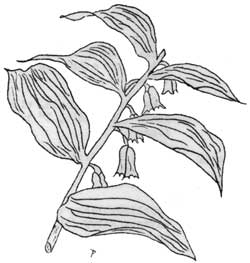 |
| Stem |
Slender, leafy, unbranched, angular and curved, 8" to 3' in height. |
| Leaves |
Toothless, oval, pointed or
lance-shaped. Appear alternately, smooth above, paler
and hairy beneath, 2" to 4" long, 1/2" to 2" wide. |
| Flower |
White or yellowish green, bell
shaped, usually in pairs; 6-lobed, 6 stamens, 1 pistil. |
| Fruit |
Round, pulpy, blue-black berry. |
This plant was formerly used in healing bruises, wounds, and skin
eruptions particularly about the eyes. It has also been used in the
manufacture of cosmetics. The berries are reputed to be poisonous.
The scientific name literally means "many knees", referring to the
joint of the rootstock. The scar left where the stem breaks away from
the rootstock is said to resemble King Solomon's Seal, hence the common
name.
FLOWERS WHITE
CHOKE CHERRY
Early June
Prunus virginiana - Rose family
Grows in all types of soil in field, meadows and along roadsides. On Mt.
Katahdin up to 4,000 feet altitude.
| Stem |
A tall shrub or tree, dark bark, smoky gray and smooth. Twigs have a
prussic acid taste. |
 |
| Leaves |
Olive green, smooth, widest above the middle, 2" to 4" long. |
| Flower |
White, in thick cylindrical clusters, petals rounded,
at the end of leafy branches. |
| Fruit |
Purplish-black, slightly bitter, berry-like with a bony stone. |
This plant is often called the Bird Cherry, because such birds as the
thrushes, vireos, and sparrows eat the fruit.
Make me a home in the forest,
Where its shadows linger deep—
Where truth shall know my spirit
And the pines their vigil keep.
—Harry T. Fee
FLOWERS WHITE
CHOKEBERRY
Early June.
Pyrus arbutifolia - Rose family.
Common in moist situations and in woods.
| Stem |
A shrub 3' to 9' high, slender, dark brown stems. |
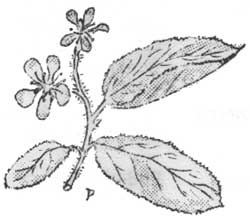 |
| Leaves |
Elliptical, oval, abruptly pointed, finely toothed,
the teeth glandular-tipped, deep olive green above, smooth and
densely woolly beneath, 1" to 3" long. |
| Flowers White, sometimes magenta-tinged, 1/2" broad in
mostly terminal clusters. |
|
| Fruit |
Berry-like, a bright garnet red, about 1/4" thick; astringent. |
Also found on the mountains here is Pyrus melanocarpa, a lower shrub
with very dark, almost black fruit.
The name Pyrus is the classical name of the common pear of cultivation,
Pyrus communis, and the common apple, Pyrus malus.
The common name indicates the power of the berry to constrict the
throats of those who eat it because of its astringent quality.
FLOWERS WHITE
DWARF RASPBERRY
May
Rubus triflorus - Rose family.
Found in meadows, fields and open woods.
| Stem |
Trailing, or ascending, no thorns, slightly woody sometimes branched,
6"-18" long. |
 |
| Leaves |
On stalks, divided into three leaflets, oval oblong-shaped,
1-1/2"-3" long, coursely toothed. |
| Flowers |
1/3"-1/2" broad, 5"-7" white, erect, oblong petals. |
| Fruit |
Red-purple, about 1/2" long. |
The name Rubus is close to the Roman "ruber" meaning red.
This plant is a relative of the common raspberry and blackberry, but
unlike these has a rather strong acid taste, and consequently is not
picked for eating.
THE OCEAN
There is a pleasure in the pathless woods,
There is a rapture on the lonely shore,
There is society, where none intrudes,
By the deep Sea, and music in its roar:
I love not man the less, but Nature more,
From these our interviews, in which I steal
From all I may be, or have been before,
To mingle with the Universe, and feel
What I can ne'er express, yet cannot all conceal.
—Lord Byron.
FLOWERS WHITE
RED-BERRIED ELDER
Early June
Sambucus racemosa - Honeysuckle family.
In rocky places, along roadsides.
| Stem |
A shrub, 2' to 12' high, twigs and leaves commonly hairy; stems woody,
the younger with reddish-brown pith. |
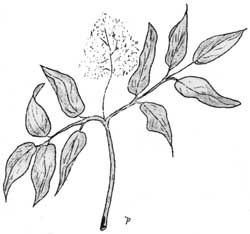 |
| Leaves |
Five to seven oval, pointed at apex, often narrowed at base, 2" to 5" long, toothed. |
| Flower |
Whitish, turning brown in drying, plume-like cluster terminating the branch. |
| Fruit |
Scarlet or red 1/6" to 1/4" in diameter, nutlets very minutely
roughened. |
Another species not so common here is Sambucus canadensis, which
has broad flat flower clusters.
The berries of this plant are sometimes used to brew a wine.
FLOWERS WHITE
EARLY SAXIFRAGE
May
Saxifraga virginiensis - Saxifrage family
Exposed rocks and hillsides in both moist and dry situations.
| Root |
Slender, fibrous. |
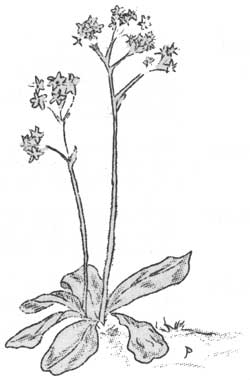 |
| Stem |
4"-12" high, naked, with sticky hairs. |
| Leaves |
Rather thick, oval or spatulate, toothed. Basal leaves
clustered. 1"-3" long. |
| Flower |
White, small, clustered, spreading. Five petals. Five
sepals. Ten stamens inserted with the petals. One pistil with two
styles. |
| Fruit |
Purplish-brown pods, many-seeded; seeds small. |
Name from saxum, a rock, and frango, to break, referring
to the habit of several species of growing upon rocks.
The roots of this plant grow down into the crevices and cracks in the
rocks and assist in the process of weathering, which makes soil from
rocks.
FLOWERS WHITE
FALSE SOLOMON'S SEAL, WILD SPIKENARD
May - June
Smilacina racemosa - Lily family.
Perennial herb of moist woods and thickets.
| Rootstock |
Thick, fleshy, creeping. |
 |
| Stem |
One to three feet high, zigzag, smooth, leafy, usually
curving, somewhat angled, nonbranching. |
| Leaves |
Many on stem, alternate, oval, pointed, strongly ribbed,
margins entire, hairy, 3"-6" long, 1"-3" wide. |
| Flowers |
Small, white, fragrant, borne in plume at the tip, six
parted, spreading segments oblong, six stamens inserted at base of
petals, one pistil, ovary 3-celled, stigma three-grooved. |
| Fruit |
A bunch of pale-red berries, specked with purple, abundant in the
early autumn, aromatic in taste. |
Pollinated by bees, flies and beetles.
Each tiny flower of the plume has six white sepals, six stamens, and a
pistil. In midsummer a cluster of speckled, pale-red aromatic
berries crowns the stem and invites the birds.
FLOWERS WHITE
Three-leaved False Solomon's Seal
Late May, Early June.
Smilacina trifolia - Lily family.
Found in bogs or wet woods.
| Stem |
Slender, erect 2" to 15" high. |
 |
| Leaves |
Two to four, usually three, from the base of the stem,
2" to 5" long, 1/2" to 2" wide. |
| Flowers |
Small, white, in an upright cylindrical cluster. |
| Berry |
Red, similar to Canada Mayflower. |
Canada Mayflower is often confused with this species, the essential
differences are:
| Maianthemum canadense | Smilacina trifolia |
| 4 sepals | 6 sepals |
| Leaves heart-shaped at base. | Leaves not heart-shaped at base. |
This plant grews in cold bogs from Labrador to New Jersey and westward
to British Columbia.
FLOWERS WHITE
COMMON CHICKWEED
Early June
Stellaria media - Pink family.
In waste places, meadows and weeds.
| Stem |
Annual, weak, tufted, much branched, 4" to 16" long, smooth except a
line of hairs along stem and branches. |
 |
| Leaves |
Lance-shaped te oval; 1/6" to 1-1/2" long, pointed, the
lower with leaf stalks, the upper against the stem. |
| Flower |
1/6" to 1/3" broad, in
terminal leafy clusters solitary in the leaf axils;
sepals oblong, mostly pointed, longer than the
two-parted petals; stamens 2 to 10. |
| Fruit |
Capsule ovoid, longer than the calyx; seeds rough. |
The chickweeds are reputedly good for birds especially the canary.
The scientific name of the plant is from "stella", meaning star and
referring to the star-shaped flowers.
FLOWERS WHITE
STAR FLOWER
Late May - June
Trientalis americana - Primrose family.
The star flower seeks the cool moist shade of the evergreen forest.
| Root |
Long, horizontal and slender. |
 |
| Stem |
Simple, erect and smooth, 3" to 9" high. |
| Leaves |
A few alternate scale-like leaves on the lower stem
and a whorl of five to ten pointed leaves just below the flowers.
1-1/2"-4:" long, 1/3"-1-1/4" wide. Lance-shaped. |
| Flowers |
White, solitary, star-shaped on slender wiry blossom stems.
Sepals seven-parted, petals seven-parted about one-half inch across.
Seven stamens, one pistil and one stigma. |
This graceful star of the woodland produces no nectar, and is a rare
instance of floral parts appearing in sevens. Usually floral parts
appear in fives, threes or multiples of these.
The name "Trientalis" means a third of a foot and refers to the usual
height of the plant.
Go slowly; we have hurried for so long
That we have missed the flowing water's song;
Have passed by all these treasures that are free -
The tinted flower, the singing bird, the skillful bee.
—Hubbard.
FLOWERS WHITE
PAINTED TRILLIUM
May - June
Trillium undulatum - Lily family.
In the shady damp woods dwells this commonest of the Mt. Desert trilliums.
| Root |
Short, tuber-like. |
 |
| Stem |
Stout, simple, reddish at base. |
| Leaves |
A whorl of three at the top of the stem, broadly oval and
pointed, 3"-8" long, 2"-5" wide. |
| Flower |
White, marked with crimson V near center, three petals,
wavy edged, three sepals, six stamens. |
| Fruit |
Three-lobed or angled, dark scarlet, 3/4" long. |
Common name for the beautiful coloring of the petals. "Trillium",
meaning "three" since all the parts appear in threes.
This is the only Trillium common on Mt. Desert, the other, Trillium
erectum, being very rare here, but common on the mainland.
This is one flower that should not be picked because picking means the
destruction of the entire plant, leaves, stem and blossom.
FLOWERS WHITE
SWEET or LOW BLUEBERRY
Early June
Vaccinium pennsylvanicum - Heath family.
Open, exposed, rocky places.
| Stem |
Low branching shrubby, 6" to 2' high, green, warty branches and nearly
or quite smooth throughout. |
 |
| Leaves |
Oblong or oblong-lance-shaped, green
and smooth on both sides, or slightly heavy on the veins beneath,
sharply toothed, pointed at both ends, 3/4" to 1-1/2" long, 1/4" to 1/2"
wide. |
| Flowers |
Few in clusters, longer than the
very short flower-stalk, oblong, bell-shaped, slightly constricted at
the throat, 1/6" to 1/5" long, about 1/7" thick, white or
pinkish. |
| Fruit |
Blue, very sweet, 1/4" to 5/12" in diameter. |
The valuation of the wild blueberry crop reaches approximately millions
of dollars annually. In blueberry districts the yearly shipment from one
small town often brings in about ten or twenty thousand dollars.
Ordinary plants would die of poison or starvation in the very acid soil
demanded by the blueberry.
FLOWERS WHITE
HOBBLE BUSH
May
Viburnum alnifolium - Honeysuckle family.
The Hobble Bush is common in cool, damp woods.
| Stem |
Woody, shrub-like. |
 |
| Leaves |
Heart-shaped, finely and irregularly
toothed, veiny, light green, finely downy above when young, smooth when
old, but very rusty-downy beneath especially on the prominent veins,
4"-8" long, with rusty-hairy stems about 1" long; turning maroon red in
late summer and the fall. |
| Flower |
Five rounded white or sometimes
pinkish lobes, in large flat clusters; marginal flowers large and showy,
sterile. |
| Fruit |
Bright scarlet or coral red, berry-like, tipped with the brown dot of
the withered calyx, 1/3" long, in flat, struggling clusters, finally
turning dull dark purple. |
| Bark |
Dull madder, purple or brown, smooth. |
The branches often droop to the ground and take root, forming loops
which may trip up a careless wayfarer; hence the common name.
Another species, Viburnum cassinoides, Withe-rod, blooms on
mountain slopes later in June.
FLOWERS WHITE
MOUNTAIN HOLLY
Late May - Early June
Nemopanthus mucronata - Holly family.
In damp, cool woods on mountain slopes.
| Stem |
Shrubby 1' to 10' high, bark ashen gray, on new stems, greenish. |
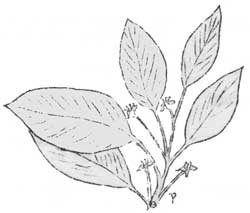 |
| Leaves |
Light green above, pale beneath, ellipse-shaped 1" to 2"
long, very slender stemmed. |
| Flower |
White, inconspicuous, less than 1/4" across, in small
clusters at the base of the leaves, on long slender stalk. |
| Fruit |
A dull berry-like fruit, light crimson red, 1/3"' diameter. August -
September. |
This plant should not be confused with the mountain holly of New York
State (Ilex monticola) which is frequently a tree 20' to 25' high and
6" to 8" in diameter.
The red fruit of Ilex verticillata (winterberry) is very similar
to that of the mountain holly, except the fruit of the latter is on long
slender stalks.
The Holly family is generally characterized by small inconspicuous
flowers and the colorful fruit which makes one of our prettiest
Christmas decorations.
FLOWERS WHITE
SWEET WHITE VIOLET
Early June
Viola blanda - Violet family
Swamps and moist lands.
| Rootstock |
Very slender. |
 |
| Leaves |
Small, light green, orbicular to kidney-shaped, heart-shaped with
shallow sinus obtuse apex, creante, 1/2"-2-1/2" wide. |
| Flowers |
White, small, 3"-6" broad, slightly fragrant, sepals
lanceolate. |
This is the smallest of the violets and also one of the earliest to
bloom, a tiny creature of the spring nestling in a mossy or grassy bank.
In the type the small white petals are broad and rounded, but the type
varies into varieties; one with upper petals long, narrow, and somewhat
recurved, often boarded and less distinctly veined; another with broader
leaves, loving woods and thickets, the white blossoms beardless and
veined. All are white, all stemless, and all most attractive and
beautiful.
Other species found here are the lance-leaved V. lanceolata and
V. palleus, similar to V. blanda.
|

